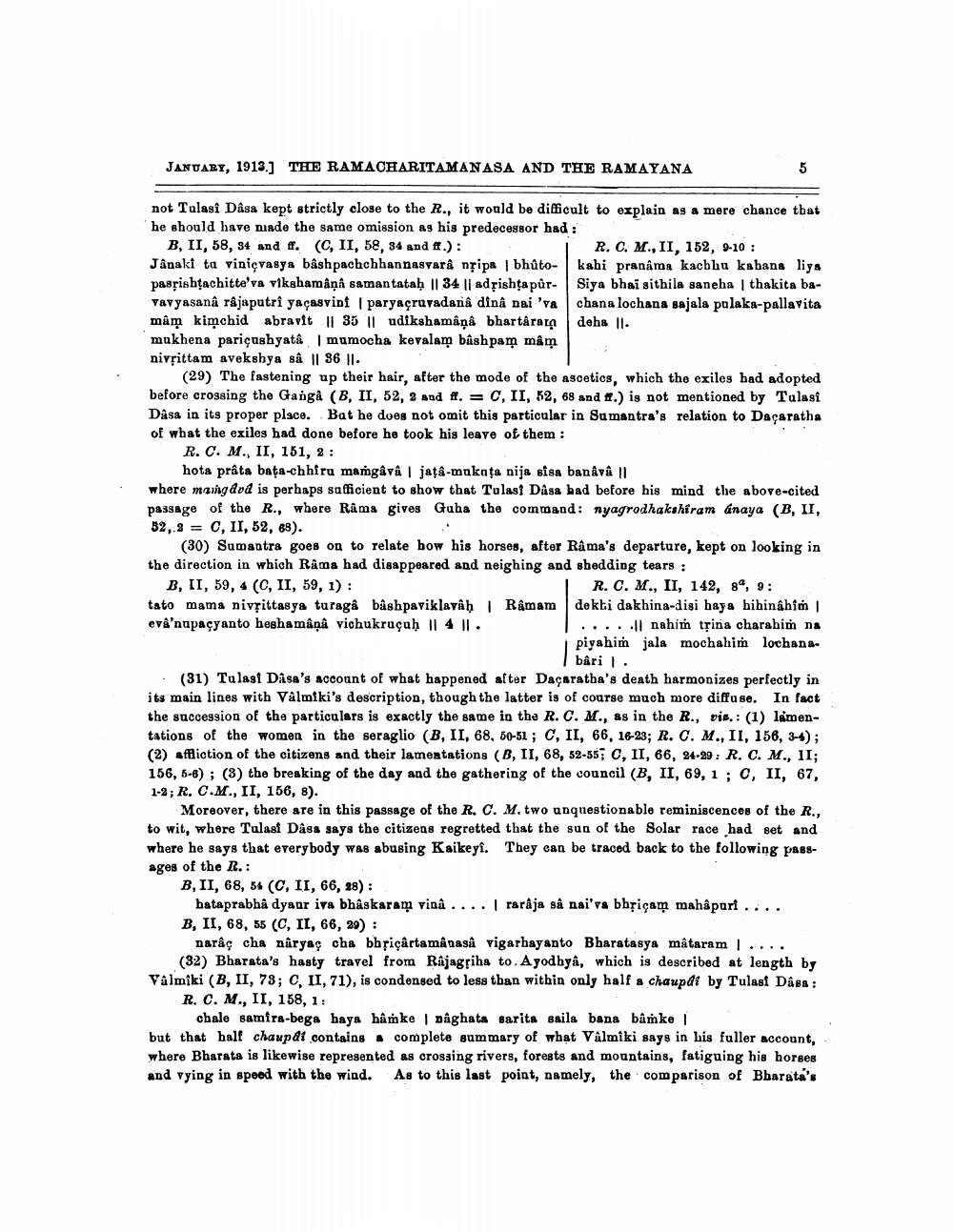Book Title: Indian Antiquary Vol 42 Author(s): Richard Carnac Temple, Devadatta Ramkrishna Bhandarkar Publisher: Swati Publications View full book textPage 9
________________ JANUARY, 1913.) THE RAMACHARITAMANASA AND THE RAMAYANA not Tulasi Dasa kept strictly close to the R., it would be difficult to explain as a mere chance that he should have niade the same omission as his predecessor had : B, II, 58, 34 and ff. (C, II, 58, 34 and ff.): R. C.M.,II, 152, 9-10 : Janaki ta viniçvasya bâshpachchhannasyarâ nipa | bhùto- kahi pranama kachhu kahana liya passishtachitte'va vikshamaņa samantatah || 34 || adsishta pûr- Siya bhai sithila saneha thakita bavavyasanâ râjaputri yaçasvint paryaçruvadana dinâ nai'vachana lochana sajala pulaka-pallavita mâm kimchid abravit ll 35 11 udikshamâņa bhartårara deha ll. mukhena paricushyatâ mumocha kevalam bash pam mâm nivrittam avekshya sa Il 36 ll. (29) The fastening up their hair, after the mode of the ascetics, which the exiles had adopted before crossing the Ganga (B, II, 52, 2 and ff. = C, II, 52, 68 and #.) is not mentioned by Talasî Dåsa in its proper place. Bat he does not omit this particular in Sumantra's relation to Daçaratha of what the exiles had done before he took his leave of them : R. C. M., II, 151, 2 : hota prâta bata-chhiru mamgåva jațâ-mukota nija sisa bankva 11 where maing dvd is perhaps sufficient to show that Tulasi Dasa had before his mind the above-cited passage of the R., where Rama gives Guha the command: nyagrodhakshfram anaya (B, II, 52,2 = C, II, 52, 68). (30) Sumantra goes on to relate bow his horses, after Rama's departure, kept on looking in the direction in which Râma had disappeared and neighing and shedding tears : B, II, 59, 4 (C, II, 59, 1): R. C.M., II, 142, 89, 9: tato mama nivsittasya turaga båshpaviklavâh Râmam dekti dakhina-disi haya hihinahin eva'napaçyanto heshamânâ vichukruçuḥ 11 4 ll. .....ll nahi tộina charahim na piyahim jala mochahin lochana bâri 1 • (31) Tulasi Dasa's account of what happened after Daçaratha's death harmonizes perfectly in its main lines with Valmiki's description, though the latter is of course much more diffuse. In fact the succession of the particulars is exactly the same in the R. C.M., as in the R., vis.: (1) lementations of the women in the seraglio (B, II, 68, 60-51; C, II, 66, 18-23; R. C. M., II, 156, 3-4); (2) affliction of the citizens and their lamentations (B, II, 68, 52-55; C, II, 66, 24-29 : R. C. M., II; 156, 6-6); (3) the breaking of the day and the gathering of the council (B, II, 69, 1 ; 0, II, 67, 1-2; R. C.M., II, 156, 8). Moreover, there are in this passage of the R. C. M. two unquestionable reminiscences of the R., to wit, where Tulasi Dasa says the citizens regretted that the sun of the Solar race had set and where he says that everybody was abusing Kaikeyî. They can be traced back to the following passages of the R.: B, II, 68, 54 (C, II, 66, 28) : bataprabha dyaar iva bhaskaram vina .... | raråja så nai'sa bhțiçam mahậpari.... B, II, 68, 55 (C, IL, 66, 29): narâc cha naryaç cha bhșicârtamâ nasa vigarhayanto Bharatasya mataram 1.... (32) Bharata's hasty travel from Rajagriha to. Ayodhyâ, which is described at length by Valmiki (B, II, 73; C, II, 71), is condensed to less than within only half a chaupdi by Tulasi Dasa : R. C.M., II, 158, 1: chale samira-bega haya hâmke | paghata sarita saila bana bûmke but that half chaupat contains a complete summary of what Valmiki says in his fuller account, where Bharata is likewise represented as crossing rivers, forests and mountains, fatiguing his horses and vying in speed with the wind. As to this last point, namely, the comparison of Bbarata'sPage Navigation
1 ... 7 8 9 10 11 12 13 14 15 16 17 18 19 20 21 22 23 24 25 26 27 28 29 30 31 32 33 34 35 36 37 38 39 40 41 42 43 44 45 46 47 48 49 50 51 52 53 54 55 56 57 58 59 60 61 62 63 64 65 66 67 68 69 70 71 72 73 74 75 76 77 78 79 80 81 82 83 84 85 86 87 88 89 90 91 92 ... 400
